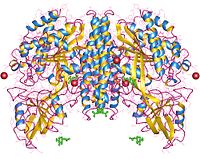
Photo from wikipedia
Fe(III) delivery from blood plasma to cells via the transferrin (Tf) cycle was studied intensively due to its crucial role in Fe homeostasis. Tf-cycle disruptions are linked to anemia, infections,… Click to show full abstract
Fe(III) delivery from blood plasma to cells via the transferrin (Tf) cycle was studied intensively due to its crucial role in Fe homeostasis. Tf-cycle disruptions are linked to anemia, infections, immunodeficiency, and neurodegeneration. Biolayer interferometry (BLI) enabled direct kinetic and thermodynamic measurements for all Tf-cycle steps in a single in vitro experiment using Tf within blood serum or released into the medium by cultured liver cells. In these media, known Tf cycle features were reproduced, and unprecedented insights were gained into conditions of rapid endosomal (pH 5.6) Fe(III) release from the Tf-Tf receptor 1 (TfR1) adduct. This release occurred via synergistic citrate and ascorbate effects, which pointed to respective roles as the likely elusive Fe chelator and reductant within the Tf cycle. These results explain enhanced cellular Fe uptake by ascorbate, the clinical efficacy of anemia treatment with Fe citrate and ascorbate, and dietary effects associated with loss of Fe homeostasis, including the large health burden of infections and neurodegeneration.
Journal Title: ACS chemical biology
Year Published: 2019
Link to full text (if available)
Share on Social Media: Sign Up to like & get
recommendations!